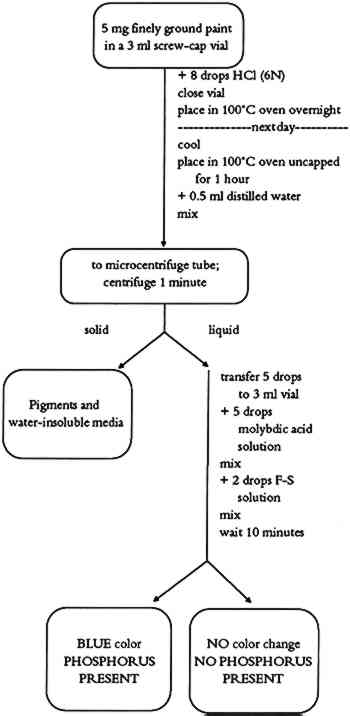BINDING MEDIA IDENTIFICATION IN PAINTED ETHNOGRAPHIC OBJECTSDUSAN STULIK, & HENRY FLORSHEIM
6 TEST FOR PHOSPHORUSCertain binding media contain phosphoproteins. In such cases, the detection of phosphorus helps to identify the binding medium. Phosphoproteins are proteins with an ester bond between the side chain of a serine (one of the amino acids found in proteins) and a phosphate unit. Casein, milk, and egg yolk contain enough phosphoproteins that the phosphorus test can be used as a secondary test for binding media identification. 6.1 METHODPhosphoproteins are hydrolyzed using a strong acid. The hydrolysate is then reacted with ammonium molybdate in an acid solution to form phosphomolybdate. A mixture of sodium bisulfite, sodium sulfite, and 1-amino-2-naphtol-4-sulfonic acid (Fiske-Subbarow reducer) is used to reduce the phosphomolybdate to form a phosphomolybdenum blue complex. 6.2 PROCEDUREThe phosphorus test flow chart is shown in figure 6. About 8 drops of 6N HCl are added to about 5 mg of finely ground paint in a 3 ml screw-cap vial. The vial is closed tightly and placed into a 100�C preheated oven overnight. The vial is removed from the oven and cooled to room temperature. The vial's cap is removed, and the vial is placed again into a 100�C oven to evaporate the acid. This takes about 1 hour. About 0.5 ml of distilled water is
6.3 COMMENTSThe test allows for identification of phosphorus in binding media. Casein gives a strong phosphorous test. If milk or egg yolk was used as a binding medium, the test is weaker due to their lower phosphorus content. |
